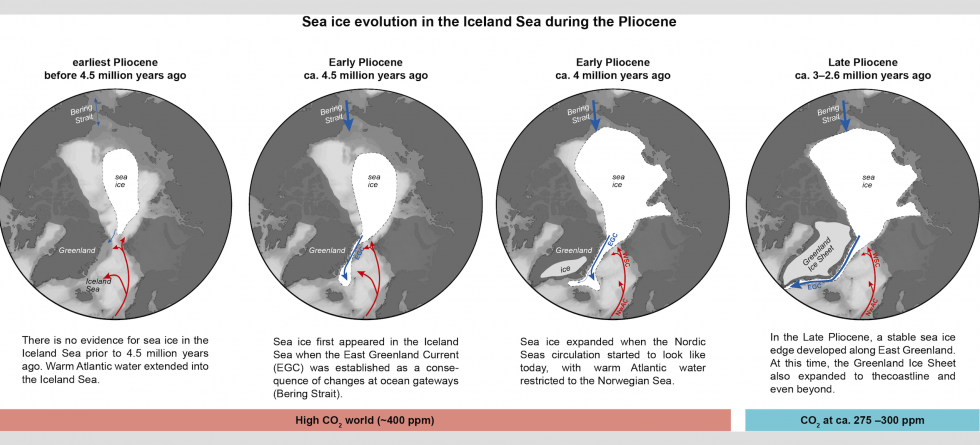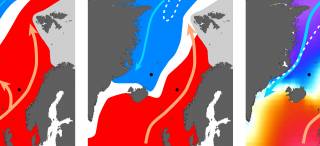The appearance of sea ice in the Iceland Sea was possible due the establishment of the East Greenland Current. That is the main conclusion of the recent publication in Scientific Reports led by Caroline Clotten, a former PhD student at NORCE Climate and the Bjerknes Centre for Climate Research.
Together with colleagues at NORCE and the Bjerknes Centre, the Alfred Wegener Institute, The University of Bremen and University of Tromsø, she has looked back into the geological record of the Early Pliocene, a time period between 5.3–3.6 million years ago.
This time period is the last time in Earth’s history when global climate was warmer than today and atmospheric CO2 concentrations were high (~400 ppm), comparable to what we have today.
Biomarkers from sea ice algae
In the study, the researchers looked into the geological record for a unique geochemical compound or biomarker (IP25) that is produced by diatoms (a group of phytoplankton) that live in the sea ice. When the sea ice melts, these components sink to the bottom of the sea, marking the extent of sea ice at a certain time.
This biomarker can be detected in Arctic Ocean sediments that are thousands to millions of years old and provide evidence of sea ice in the geological past. Clotten and colleagues now provide the first direct evidence that seasonal sea ice occurred sporadically from ca. 4.5 million years ago in the Iceland Sea.
– Sea ice is an important component of our climate system. The result shows that sea ice was present in the Iceland Sea in the Early Pliocene, despite warm temperatures and high CO2 level. It is important to stress that the sea ice distribution was less extensive than today and depended on the East Greenland Current, Caroline Clotten says.
The formation of the modern Nordic Seas circulation
– Our new findings indicate that large-scale circulation changes played a pivotal role in the first appearance of sea ice, Caroline Clotten says.
The study shows that sea ice appeared and expanded due to large-scale changes in the regional and global oceanography. The researchers relate the increasing occurrence of sea ice in the Iceland Sea during the Early Pliocene to the establishment of East Greenland Current and a Nordic Seas surface circulation that started to look as today.
– That we can find clear evidence for sea ice in the Iceland Sea in the period 4,5 million years ago is new and it support earlier findings on the establishment of the East Greenland Current around that time. The result tells us that the East Greenland Current was bringing sea ice southwards, or that the current made it possible for sea ice to form in the Iceland Sea, says Stijn De Schepper, researcher at NORCE and the Bjerknes Centre.
Today, a cold-water current known as the East Greenland Current flows southward along the east coast of Greenland and transports the majority of all exported Arctic sea ice. In contrast, the Nordic Seas near Scandinavia is much warmer, giving rise to the characteristic east-west temperature gradient. The warm water near Scandinavia is brought northwards via the Norwegian Atlantic Current, a continuation of the Gulf Stream, and is today responsible for the mild winter climate along the coast of Norway. As a result, the southernmost part of Greenland is at the same latitude as Bergen and Oslo in Norway, but the climate in Greenland is much cooler.
Limited sea ice in a warm global climate
Comparing insights from the geological record to the modern day or future is not straight forward, as the timescales are vastly different. In this study, several hundred thousand of years of climate and sea ice evolution were covered, while the ongoing transition to a globally warmer world and the decreasing Arctic sea ice extent is happening within a few generations.
Nevertheless, the Early Pliocene geological record provides some crucial insights into a high CO2 world and a warm global climate. Under such conditions, sea ice appeared in the Iceland Sea but only due to a major change in oceanography. The sea ice occurred sporadic and remained limited there. As a consequence, warm surface waters could still extend to the coast of Greenland, where only mountain glaciers occurred.
In a previous publication, Clotten has showed that an extensive sea ice cover only developed along East Greenland in Late Pliocene (from ca. 3 million years ago), isolating Greenland from warm surface water and contributing to the albedo effect. Together with atmospheric CO2 concentrations reaching below ~275 ppm, such setting helped to grow an ice sheet on Greenland that extends to and even beyond the coastline.
Reference:
Clotten, C., Stein, R., Fahl, K., Schreck, M., Risebrobakken, B. & De Schepper, S., 2018. On the causes of Arctic sea ice in the warm Early Pliocene. Scientific Reports, doi:10.1038/s41598-018-37047-y.



